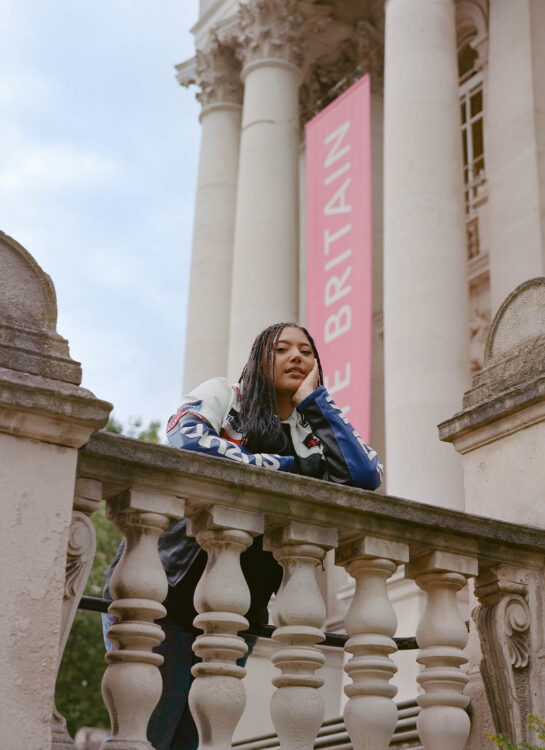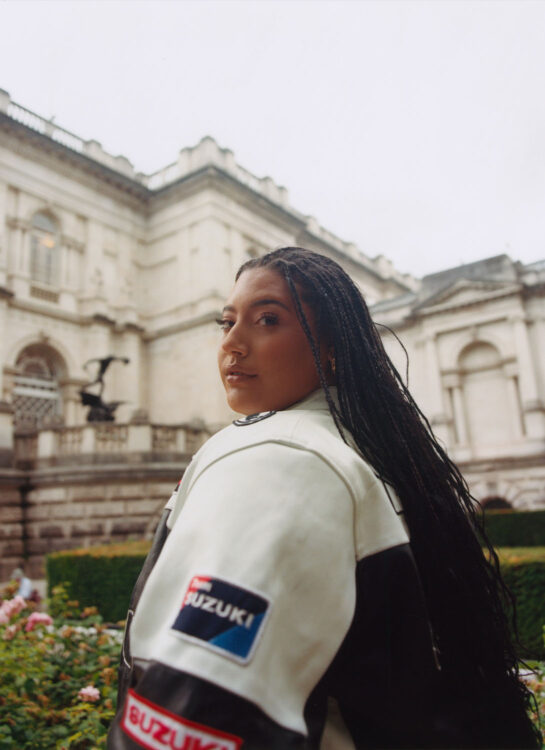- Words Matilda Carnall
- Director Duncan Lewis
- Photography Serena Brown
- Creative Direction Daisy Deane @ DELA. Studio
- Makeup Cherise Currie
- Production Studio Notion
- Assistant Director Matt Turner
- 2nd Assistant Director Alfie Casting
- Runners Charlie Brown & Lilly Turley
Tastemaker Tiffany Calver meets us at Tate Britain to discuss the beauty of creativity, the renaissance of hip-hop culture, and the female artists in whom she finds solace.
Art is a universal language, as Tiffany Calver shares, sat among some of the greatest paintings in British history. It’s a means to understanding history, culture, and what goes on in the minds of others. But it doesn’t have to be taken so seriously. For too long, there has been an unease surrounding galleries, she explains – especially for younger people who aren’t as well acquainted with the arts or didn’t grow up in creative spaces.
Things are changing though. As musicians and artists alike continue to explore the bounds of creativity, art is diversifying, and becoming ever more accessible. Today, you can discover over 800 works at Tate Britain for free, spanning six centuries – from John Everett Millais’ Ophelia to contemporary works by Lubaina Himid. And, thanks to the Tate Collective scheme, young people can discover art in even more unexpected ways, with £5 exhibition tickets, exclusive discounts and unmissable events.
As art continues to meld with the music world – whether that’s the crossover between Central Cee and London artist Slawn, or, more universally, art’s powerful influence on our emotions and the songs born out of that – the lines between disciplines are blurring.
Tiffany Calver could be described as somewhat of a curator herself, fusing artistry, creativity and newness within the hip-hop sphere. With a strong appetite for culture, she brings her blends of trap, hip-hop, and fresh UK sounds to UK national radio. Considered a musical tastemaker, the radio DJ’s launched her own record label, ‘No Requests’, as well as debuted the likes of Divine Council and AJ Tracey in her Tiffany Calver & Friends shows. The first-ever female host of The Rap Show on BBC Radio 1, she has made herself known by championing the up-and-comers within the music scene – piecing together the future of hip-hop as if her own sonic gallery.
We brought Tiffany Calver to Tate Britain to discuss the emotions that art evokes in her, the renaissance of the original hip-hop culture, and the female artists she finds solace in.




First up, what inspires you to make your own version of art?
I think the thing that inspires me the most is getting out into the world, looking around, and listening. I love people-watching and figuring out what their story is. I love reading stories and I love art in all different forms, whether it’s paintings, photography, music. I think that art ebbs and flows throughout so many areas of life. The most beautiful thing to me is being able to take what has inspired me and give it back in my version of art, share that feeling – and hope that it continues.
How does art help to inspire your creative process?
I don’t think that a creative process exists without art. There’s always this thing about originality, but I’m not sure originality really exists because we are constantly influenced and inspired by things around us – especially creativity. You can’t escape it, it’s the thing that connects everyone, a universal language. You know, you don’t have to speak the same language as someone else to feel something – and that’s the beauty of art. It’s a feeling. It’s not something you have to say, but something you can project.
How do you think that galleries spark inspiration?
I think that people can find gallery spaces and museums quite intimidating because there can be this seriousness around them. For me, the way I got into going to galleries was through my job and travelling. I’d be in a city and would want to see something different – without the intimidation of ‘this is a serious thing to do’. So me and my friends would go into museums and make it our own experience – it could be as childish or mature as we wanted it to be. We’d make humour out of it, we’d smile, we might cry sometimes, we might have a conversation around a piece of art. And I think that’s the beauty of museums. It’s being able to see something from the 1700s or the 1400s and there’s still something in it that inspires you.
In your opinion, how can art influence and connect everyone?
You have to take the pressure away from it. I think places like the Tate are really special when you don’t look at them through such a serious lens. When you just come here and be, stand, look at something and think about how you feel. It’s also the fact that these spaces are available to us and free. You can come and get inspired in ways you never thought you would. I’m inspired being here today, and you can look back and be like, how would I even connect with a room like this? You know, I’m a 90s baby, I’m in 2023, how can I connect? But you do, and I think that’s why these places are really special.



Is there a specific period of art that you’re interested in?
I’m not really stuck to one time period. I like walking into galleries and looking at all walks of life and all periods of time, because you connect in ways you never thought you would. These aren’t things you’re reading in a history book, or being taught in class. These are reflections of how somebody felt in a moment of time that we will never be able to visit. We get to visit through these pictures, instead, and feel those feelings.
What type of art inspires you?
I love all kinds of art. Everything is art to me. Anything that brings me peace and lets me escape from the world for a minute, whether it’s a song I love, a photograph, a film. There are so many different varieties of art that just help you to breathe for a second and find peace. Or maybe not, maybe it’s finding anger, finding sadness – but you find something in it.
Do you find yourself particularly influenced by female artists?
Oh, 100%. I think that’s literally what has raised me. And in all forms, whether that’s Tracy Emin and how outrageously unapologetic her art is, literally heart on her sleeve. I think that’s beautiful. Whether that’s going back to musicians I was raised on, through my mother, through my grandmother. You know, I love someone like Nina Simone; one of my favourite samples in history is “Sinnerman” and I think that’s something that was passed down to me. That’s art. The art by women that most connects to me is the outspoken art, the rebellious art of the time. The people that chose to stand up or be unapologetically themselves, and do what they wanted to do. That’s what inspires me the most.
How do you think the worlds of art and music collide?
I come from the world of hip-hop. The thing I loved and that got me obsessed with hip-hop from when I was a kid, was the fact that it meshes so many different worlds without meaning to. When hip-hop first started, there was dance, there was street style, there was sneakers. All of these exciting elements make you who you are, and I think there’s been a renaissance of that in recent years.
Like, there’s Slawn, who’s connected to Central Cee – [Cee]’s got Slawn painting a double-decker bus and posting it on Instagram and these kids are seeing it and getting inspired. I’ve got a 14-year-old brother who tells me how cool it is, and it brings art into the conversation in a less forced way – because sometimes it can feel like it’s forced on the younger generation to be interested in art.
Watch Tiffany Explore:
To discover how art influences you, Tate Britain and Tate Modern are free to visit all year round. Between 16 and 25? Sign up here to become a member of Tate Collective for £5 exhibition tickets, discounts across food and drink, and unmissable events.

